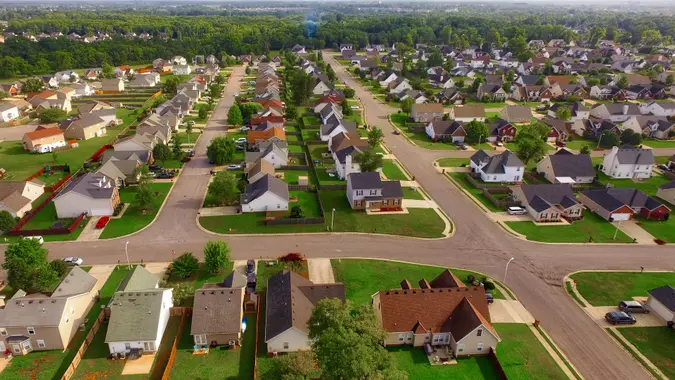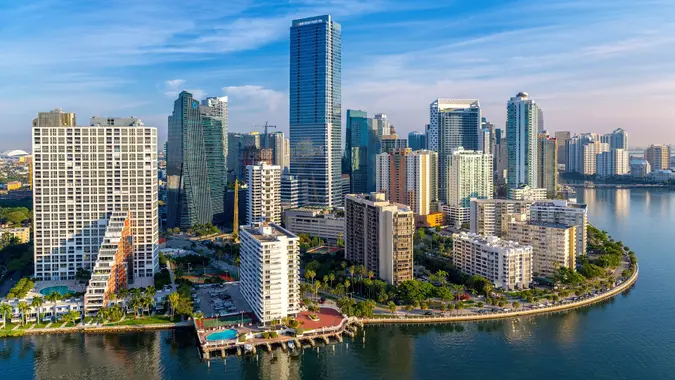4 Ways Trump’s Housing Policies Could Affect Middle-Class Homebuyers

Commitment to Our Readers
GOBankingRates' editorial team is committed to bringing you unbiased reviews and information. We use data-driven methodologies to evaluate financial products and services - our reviews and ratings are not influenced by advertisers. You can read more about our editorial guidelines and our products and services review methodology.

20 Years
Helping You Live Richer

Reviewed
by Experts

Trusted by
Millions of Readers
Affordable housing is a huge issue for American voters as they choose between former President Donald Trump and Vice President Kamala Harris for president.
According to a survey by the National Association of Home Builders, the average American family spends at least 38% of their household income on their mortgage. In addition, U.S. home prices have risen by 47% in the past decade.
Trump said inflation was a primary cause of the current state of the economy.
“We have inflation like very few people have ever seen before, probably the worst in our nation’s history,” Trump said in a recent presidential debate. “We were at 21%, but that’s being generous because many things are 50%, 60%, 70%, and 80% higher than they were just a few years ago.”
Many of Trump’s economic policies are aimed at lowering inflation, which the national Republican platform said would “reduce mortgage rates by slashing inflation.”
Here are four ways Trump’s housing policies could affect middle-class homebuyers. You can also check out several ways a Trump presidency could help middle-class taxpayers.
Easing Home Shortages
Trump proposed open federal land to build new homes, which may ease home shortages afflicting the country.
The plan’s basic concept has bipartisan support. The federal government owns about 28% of the nation’s land and would open bidding to developers who promise to keep a certain percentage of the new units available for affordable housing. The proposal could increase the land available for construction, especially in high-demand areas, while helping to ease housing shortages and decrease prices by increasing supply.
However, Republicans and Democrats disagree on whether the federal land for sale should be vacant. There are also no guarantees that developers will earmark a portion of the newly opened federal land to build affordable housing.
Make It Faster and Easier To Build New Homes
As a real estate developer, Trump said he endured excessive construction and development regulations and has pledged to reduce them if re-elected.
“You’re talking about cutting your [permits] down in half,” Trump said in a Bloomberg interview in July. “Your permits, your permitting process. Your zoning, if–and I went through years of zoning. Zoning is like… it’s a killer. But we’ll be doing that, and we’ll be bringing the price of housing down.”
According to research from the National Association of Homebuilders, government regulations account for over 40% of apartment development costs.
Eliminating business regulations could make it easier and faster to build new homes, lowering builders’ costs and possibly creating more affordable housing options for middle-class homebuyers.
“The deregulations and streamlining the process for private developers will help lower the costs of building new homes, which will expand supply,” said Wayne Winegarden, an economist with the Pacific Research Institute. “The expanded supply will help improve affordability.”
Lower Home Prices by Increasing Fossil Fuel Production
The U.S. reportedly produced more than 827.1 million metric tons of oil last year, reaching a record high. That’s enough oil to fill about 17 billion average car gas tanks or every car on earth several times.
Trump pledged to lower energy costs for consumers by half if he wins re-election. Increasing fossil fuel production impacts home costs because energy prices consume a significant portion of construction costs.
“Your heating and air condition, electricity, gasoline — all can be cut down in half,” Trump said at a campaign stop in Michigan.
The former President also promised to increase oil supply and lower costs by declaring a “national emergency.”
A U.S. President can create an “optimal” environment for the fossil fuels industry through tax breaks and deregulation. The president can also encourage other oil-producing countries to produce more or less. However, Helima Croft, managing director and global head of commodity strategy at RBC Capital Markets, told NBC News that presidential power to influence energy prices is limited.
“He’s not going to be able to increase U.S. oil production by his signature in a way that would materially bring oil prices down by half,” she said.
Make Building Materials More Expensive
Earlier this year, Trump promised to levy a 60% tariff on Chinese imports, one of his most controversial positions among economists during the 2024 campaign.
During a recent campaign rally in Wisconsin, Trump said he would impose a 100% tariff on countries that “shunned the U.S. dollar,” creating a “lose-lose” situation for America and China.
Regarding affordable housing, increasing trade tariffs could escalate the cost of common housing materials like steel and lumber. The United States imported nearly $613 million in iron and steel from China last year, according to a United Nations database on international trade. Deepening a trade war with China could counteract Trump’s other policies to alleviate housing prices.
“On net, it’s unclear what the impact on housing affordability would be if the full suite of Trump’s policies is implemented,” Winegarden said.
Editor’s note on election coverage: GOBankingRates is nonpartisan and strives to cover all aspects of the economy objectively and present balanced reports on politically focused finance stories. You can find more coverage of this topic on GOBankingRates.com.
 Written by
Written by  Edited by
Edited by 

























